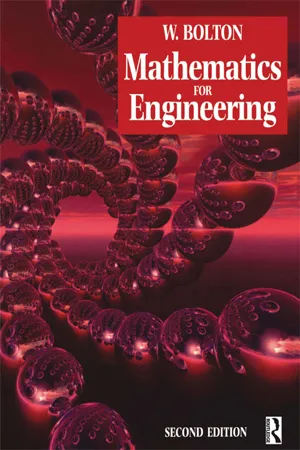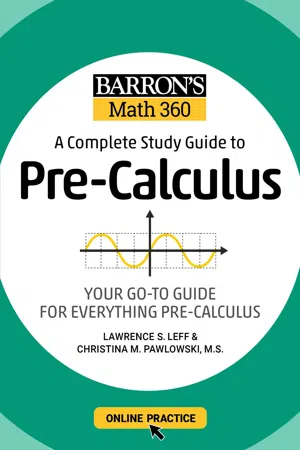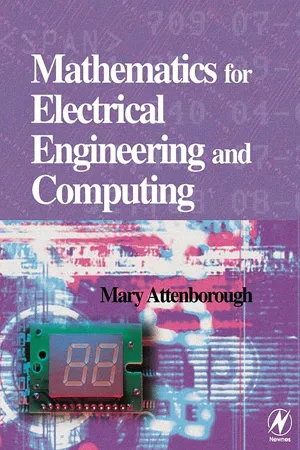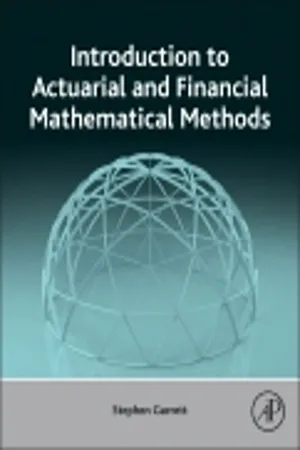Mathematics
Generating Terms of a Sequence
Generating terms of a sequence involves finding the individual elements of a sequence based on a specific rule or pattern. This can be done by applying the given rule to each term in the sequence to generate the subsequent terms. The process of generating terms of a sequence is fundamental in understanding patterns and relationships in mathematics.
Written by Perlego with AI-assistance
Related key terms
5 Key excerpts on "Generating Terms of a Sequence"
- eBook - ePub
- W Bolton(Author)
- 2012(Publication Date)
- Routledge(Publisher)
sequence because they are stated in a definite order, i.e. 1 followed by 3 followed by 5, etc. In the above sequence of 1, 3, 5, 7, 9, each successive member is formed by adding 2 to the previous member. Another example of a sequence is money in an interest-earning bank account. Initially there might be, say, £100 in the account. If it earns interest at the rate of, say, 10% per year then after 1 year there will be £110 in the account. At the end of the next year there will be £121 in the account. At the end of the next year £132.1. The sequence of numbers describing the amount in the account at the ends of each year are:£100 £110 £121 £132.1 We have a sequence of numbers where there is a definite relationship between successive values.The term series is used for the sum of the terms of a sequence. There are many instances in mathematics were we have values which we can express as series and so aid calculations. A particular useful series is termed the binomial series (or binomial theorem) and is frequently used to simplify engineering expressions. In this chapter we consider the arithmetic, geometric and binomial series.7.2 Sequences
The term sequence is used for a set of numbers in a definite order. Thus 1, 2, 3, 4, 5 is a sequence where it is easy to see there is a definite order in forming each member of the set. We can describe the terms in the sequence by stating the law by which the sequence is formed as: add 1 to the previous term. Thus the sequence 1, 2, 3, 4, 5 is obtained by starting with a 1 and then adding 1 to it to obtain the next term, then adding 1 to it for the next term and so on for each successive term in the sequence. The sequence 3, 6, 12, 24, 48 is obtained by starting with a 3 and then multiplying it by 2 to give the next term, then multiplying by 2 for the next term and so on for each successive term. The sequence 2, 4, 16, 256 is obtained by starting with a 2, then squaring it to obtain the next term and so squaring each term in sequence. The following sections discuss some of the common forms of sequences.When a series finishes after a certain number of terms it is said to be finite; when there is an unending number of terms it is said to be infinite.Revision1 Determine the laws governing the numbers in the following sequences:(a) 2, 4, 6, 8, (b) 5, 10, 20, 40, (c) 1, −1, 1, −1.7.2.1 Arithmetic sequence
An arithmetic sequence (sometimes called an arithmetic progression) is one where each term is formed from the previous one by simply adding a constant value. Thus if a is the first term and d - Lawrence S. Leff, Christina Pawlowski-Polanish(Authors)
- 2021(Publication Date)
- Barrons Educational Services(Publisher)
Sequences can be described by formula-type expressions. The sum of any number of consecutive terms of a generalized sequence can be indicated by using the symbol Σ, the capital Greek letter sigma.VIEWING A SEQUENCE AS A FUNCTION
A sequence is a function whose domain is a set of consecutive whole numbers that represent the position numbers of the terms in the sequence and whose range is the corresponding terms of the sequence. Instead of using standard function notation such as a(1) to indicate the first term of the sequence, a(2) to indicate the second term, and so forth, the terms or function values of a sequence are represented by the subscripted variables a1 , a2 , a3 , …, an, …, where the position of a term is indicated by its subscript. The notation {an} refers to the entire sequence in which anis a general term.For the sequence 10, 15, 20, 25, and 30, the domain is the set of position numbers, {1, 2, 3, 4, 5}, and the range is the corresponding set of terms, {10, 15, 20, 25, 30}. If a represents this sequence function, then a1 = 10, a2 = 15, a3 = 20, a4 = 25, and a5 = 30.EXPLICIT VERSUS RECURSIVE FORMULAS
A sequence may be defined explicitly or recursively.•A sequence is defined explicitly when a formula is given that tells how to obtain all of the terms of the sequence without knowing the identity of any specific term. The formula an= 2n + 1 defines a sequence explicitly since it tells how to obtain each term without knowing any other term:•A sequence is defined recursively when all of its terms can be obtained by a statement that relates a general term of the sequence to one or more terms of the sequence that preceded it. Suppose that a1- Mary P Attenborough(Author)
- 2003(Publication Date)
- Newnes(Publisher)
Chapter 14 .A sequence is a function of natural numbers, or integers. The function expression is given by the general term.Example 12.1
Find the general term of the sequence of numbers from 1 to 10Solution 1, 2, 3, 4, 5, 6, 7, 8, 9, 10 has the general termWe can also write this in ‘standard’ function notation asan = n, where n = 1 to 10.a ( n ) = n , where n = 1 to 10.Check: To check that the correct general term or function expression has been found, reproduce a few of the members of the sequence by substituting values for n in the general term and check that the sequence found is the same as the given values. Wherever n occurs in the function expression or general term replace it by a value.a n= nfor n = 1 givesa 1= 1for n = 2 givesa 2= 2 , etc .Example 12.2
Find the general term of the sequence 1, 4, 9, 16, 25, 36, … and also define the sequence in terms of a recurrence relation.Solution Notice that each term in the sequence is a complete square. The first term is 12 , the second term 22 , etc. We therefore speculate that the general term isIn function notation this isa n=n 2, where n = 1 to ∞ .a ( n ) =n 2To define the sequence in terms of a recurrence relation means that we must find a way of getting to the n + 1 th term if we know the n th term. There is no prescribed way of doing this: we merely have to try out a few ideas as to how to see a pattern in the sequence. In this case, we can best see the pattern with the aid of a diagram where we represent the ‘square numbers’ using a square as in Figure 12.1 . Here we can see that to get from 22 to 32 we need to add a row of two dots and a column of three dots. To get from 32 to 42 we need to add a row of three dots and a column of four dots. In general, to get from n 2 to (n + 1)2 , we need to add a row of n dots and a column of n- eBook - ePub
- Walter D. Wallis, John C. George(Authors)
- 2016(Publication Date)
- Chapman and Hall/CRC(Publisher)
Chapter 6Generating Functions and Recurrence Relations6.1 Generating Functions
Some kinds of combinatorial calculations are modeled by the behavior of infinite power series or even finite power series (i.e., polynomials). For instance, we considered in Chapter 2 how to determine the number of ways of selecting k items from a set of n; for simplicity, we will consider n − 4, k = 2. Suppose we wish to multiply (1 + x1 )(1 + x2 )(1 + x3 )(1 + x4 ). In the product, we ask how many terms of the form xi xj there will be; clearly,of them, since that is how many ways we can choose two of the factors to contribute an xi . Now, if we set x1 = x2 = x3 = x4 = x, the product is the polynomial (1 + x)4 . The coefficient of x2 in this product is(= 64 2)(The reader will recall that this subscripting technique is how we proved Theorem 2.3, the Binomial Theorem.) In the same way, some numbers of combinatorial interest (such as a sequence of integers) have properties that become clear or easier to prove when they are used as coefficients of a polynomial or an infinite series. These considerations motivate us to define the generating function of a sequence a0 , a1 , … to be the formal power series(= 64 2).∑i ≥ 0a ix iThe expression formal power seriesindexformal power series is understood to mean that we do not evaluate the power series at any point, or concern ourselves with the question of convergence necessarily. Indeed, some uses of generating functions do not require infinite series at all; in this case we shall assume that an = 0 for all n greater than some specific integer N.Example 6.1: Suppose we wish to buy a dozen donuts from a shop with varieties v1 , v2 , v3 , and v4 . We want between three and five donuts of variety v1 (because the shop has only 5 available, and at least three people will want one); similarly, we require 1 ≤ |v2 | ≤ 10, 4 ≤ |v3 | ≤ 6, and 0 ≤ |v4 - Stephen Garrett(Author)
- 2015(Publication Date)
- Academic Press(Publisher)
Chapter 4 and are particularly useful for evaluating limits.5.1 Sequences
As sequence is simply an ordered set of terms that are determined by a pattern or rule. The most obvious example of a sequence would be1 , 2 , 3 , 4 , …This sequence starts at 1 and is defined by adding 1 to the previous term. Mathematically, we would say that the n th term of the sequence is n forn ∈. Recall that in Chapter 1 , we defined N to begin at 0 andN +N +to begin at 1. It is then clear that the sequence continues as5 , 6 , 7 , 8 , …A slightly more complicated example of a sequence would be0 , 3 , 8 , 15 , …which has n th term given by n 2 − 1 forn ∈. This sequence would continue as 24,35,48,63,….N +We are careful to define a sequence as an “ordered set of terms ” because a sequence need not necessarily be numerical. For example,a , b , c , d , …is a perfectly well-defined sequence of terms, defined alphabetically. However, in this book, we are particularly concerned with numbers and so we will be restricted to numerical sequences in all that follows.Although it is useful to define a (numerical) sequence in terms of a mathematical rule and a starting value, this is not always necessary and sequences can be presented simply as an ordered set of numbers. For example, the numerical sequences given above could be presented as{ 1 , 2 , 3 , 4 , … } and { 0 , 3 , 8 , 15 , … }Note that we have used the notation {}, however a sequence defined like this is not actually a set in the strict sense. Recall that a set, as discussed in Chapter 1 , is presented as a collection of unique
Index pages curate the most relevant extracts from our library of academic textbooks. They’ve been created using an in-house natural language model (NLM), each adding context and meaning to key research topics.




